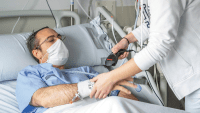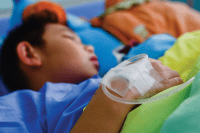A principle that guides nursing practice.
Piedmont Fayette Hospital in Fayetteville, Georgia, has been on a journey to promote a culture of interprofessional decision-making since before its first Pathway to Excellence® designation in 2015 (the second was in 2018). This deeply rooted culture—which encompasses unit-based councils, hospital committee representation, huddles, debriefings, multidisciplinary communication, and recruitment—empowers all nurses to have a voice in their practice and work environment.
Unit-based councils
Nursing shared governance is the foundation of nursing collaboration and shared decision-making. Initially, our shared governance councils were hospital-wide and carried a broad purpose. As the councils began working on projects, nurses wanted to be involved in making changes and promoting the Pathway to Excellence standards on their own units, so we transitioned to unit-based councils (service lines, med–surg, emergency, critical care, and others) to give nurses sense of ownership, teamwork, and connection. We also created a nursing leadership council, which consists of the chair and co-chairs of each unit-based council, the department directors, and the chief nursing officer. The hospital has invested in the shared governance councils by sending council chairs to Lean Six Sigma training to acquire the skills they need to complete projects successfully.
If a project involves more than one department or service line, a temporary task force composed of all stakeholders leads the project. The task force disbands after project completion and evaluation. Projects take 6 months to a year to complete, depending on difficulty.


Unit-based council at work
Two nurses on a med–surg unit at Piedmont Fayette Hospital attended a conference on evidence-based practice and learned that similar units in other hospitals had RNs take the first set of vital signs on each shift.
The hospital’s current practice was for patient care techs to take the first set of vital signs on as many as 15 patients, making the time between the first patient’s vital signs and the last significant. Med–surg nurses have a 1-to-5 nurse–patient ratio, so if nurses would take the first set of vital signs, patient care techs would have time to begin patients’ baths and get them ready for breakfast or ambulating.
The nurses who attended the conference presented this idea to the med–surg unit council as a potential practice change. The council completed a literature search that confirmed it as a best practice. Discussions about the proposed change began in the council meetings and then were shared with leaders and direct-care nurses for support.
The staff of a 23-bed surgical unit volunteered to participate in a trial. Education took place at day- and night-shift safety huddles and during staff meetings. Nurses were given an email address to share thoughts and concerns about the change. Staff found that nurses taking the first set of vital signs aided patient care assessment and helped them address changes in a patient’s condition, resulting in better outcomes. The unit adopted this new practice with plans to introduce it to other med–surg units.
Hospital committee representation
Nurses share in decision-making outside of shared governance by participating in various hospital committees. For example, the sepsis team is championed by a stat nurse and includes physicians (intensivist and hospitalist) and other nurses (critical care, stat team, med–surg, emergency department). The committee meets monthly to discuss quality metrics, wins, and challenges. The nurse champion is part of the system-level sepsis team, which provides updates and changes to sepsis treatments. The addition of new nurse graduates year-round requires ongoing staff education about sepsis protocols and treatments. All new hires spend a day with the stat nurse learning about sepsis protocols.
Huddles
Daily pre-shift and patient safety huddles began at Piedmont Fayette Hospital in late 2011. At the time, most employees were unfamiliar with the huddle concept. Now, huddles are integrated into practice and a source of daily shared decision-making.
Every department and every nursing unit has a pre-shift huddle to discuss the day’s events and concerns and to review safety principles and error-prevention tools. The huddles also are used for announcements, education, and any hospital-wide issues that may affect unit operations. If a unit seems overwhelmed, a charge nurse may call for a mid-shift huddle to help the unit prioritize, find out who needs help, and determine who can offer assistance.
Patient safety huddles are held every day at 10 am and 10 pm, and they typically last 15 minutes (maximum 30 minutes). A representative (manager or team member, such as a direct-care nurse) from each department attends the meeting; nursing units usually send charge nurses. Each patient safety huddle begins with a promise story (something good that’s happened) or safety story (a concern or win). Then each department gives a brief “state of the unit” report. These reports help alert everyone to any issues that may affect them. For example, if a computed tomography unit is down in radiology and won’t be repaired until late in the evening, nursing units can be prepared to inform patients and families that procedures may be delayed. Those involved work together after the huddle to find solutions.
Safety huddles also give direct-care nurses the opportunity to voice concerns and ask for assistance. Others can then join the conversation. For example, a direct-care nurse might report a difficult patient experience and request assistance and guidance on how to handle the situation. Other departments (such as case management, security, patient experience), management, or executive staff may offer assistance and meet after the safety huddle to provide a quick resolution. When nurses are included in this collaborative process, they can see the results, which builds trust in leadership and lets them know it’s safe to speak up.
During the hospital’s COVID-19 surges, pre-shift huddles continued on the units, and safety huddles were virtual. A 24/7 incident command center allowed staff to call for information or assistance at any time.
Debriefings
Debriefings are a critical element of the healthcare safety tool kit. They can be called by any staff member after an event, usually a difficult patient situation. Discussions, led by the parties involved, focus on what went well, what could have been done better, and what requires follow-up. The whole team participates in the debriefing, which aids process improvement.
Multidisciplinary rounds
Multidisciplinary rounds (which include the primary nurse, provider, care manger, patient, and family) occur daily on the nursing units. Other disciplines, such as physical therapy or nutrition, also may participate as needed. During these rounds, decisions are made about current treatment plans, discharge planning, and other issues that can help patients better manage their care at home.
During the first COVID-19 surge, the care team sought ways to continue to have multidisciplinary rounds. Using two telehealth monitors, the stat nurse, physicians, unit managers, and charge nurses developed a process to continue rounds. Physicians had a monitor in their work area while nurses moved the other monitor from patient to patient. FaceTime and other mobile device applications were used to connect with the family during rounds.
Recruitment
Nursing departments use shared decision-making in the hiring process. A panel of direct-care nurses and clinical managers conduct interviews using a system of behavioral questions, standard questions, and point grading. Nurses who serve on the panel score each question, and those scores are considered in the hiring decision. Unit nurses also take candidates on tours of the unit, which allows them to get a sense of whether a candidate is a good fit for the team.
Guiding principle
Piedmont Fayette Hospital nurses have worked hard to create a shared governance program, participate on committees, and have a voice in processes that affect their practice and patient care. (See Collaboration in action.)
Collaboration in action
The intensive care unit (ICU) at Piedmont Fayette Hospital recently participated in shared decision-making related to equipment purchase and unit expansion.
Equipment purchase
Direct-care nurses told their unit manager and director that they found a certain brand of bed (VitalGo) to be important to their practice and patient care, especially with the increased need for beds during the COVID-19 pandemic. The bed allows nurses to measure patient weight bearing for progressive, early mobility therapy. Nurses witnessed the positive progress patients made when the bed was used. However, it wasn’t always available to rent.
The team explored the cost of renting vs. owning a bed and found that owning would provide cost savings.
At the same time, a local civics group donated a large sum of money for the ICU. The nurses advocated for using
the donation to purchase the bed. Management and the executive team approved the bed recommendation, and several beds have been purchased.
Unit expansion
During a COVID-19 surge, the ICU swapped its physical space with a larger unit to increase critical care beds from 14 to 30. After a few months, it was decided that a need for the 30 beds still existed and that the swap would be permanent.
Direct-care nurses were asked to make a list of renovations and other items needed to transform the unit into a permanent ICU. The list was presented to the director and executive team, and current discussions are taking place. Because of shared decision-making, critical care nurses have a voice in what the unit needs and how it will be designed.
The Pathway to Excellence program, including standard one (shared decision-making), provides a guiding framework for many of the hospital’s nursing projects.
Gloria F. Giordano is manager of nursing programs at Piedmont Fayette Hospital in Fayetteville, Georgia.
References
What is lean healthcare? NEJM Catalyst. April 27, 2018.
Cardona-Morrell M, Prgomet M, Lake R, et al. Vital signs monitoring and nurse-patient interaction: A qualitative observational study of hospital practice. Int J Nurs Stud. 2015;56:9-16. doi:10.1016/j.ijnurstu.2015.12.007
Fasolino T, Verdin T. Nursing surveillance and physiological signs of deterioration. Medsurg Nurs. 2015;24(6):397-402.


















